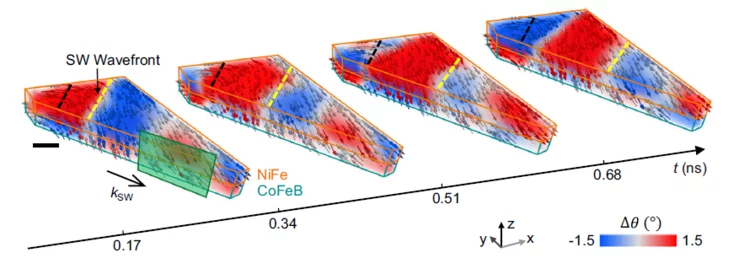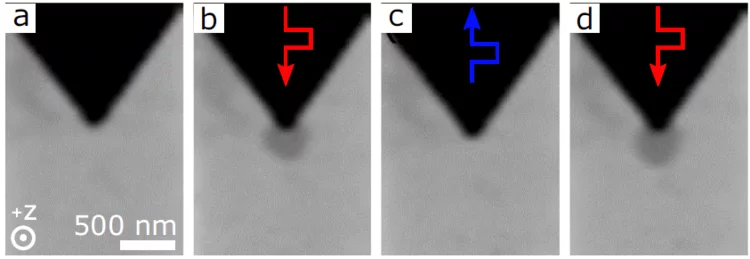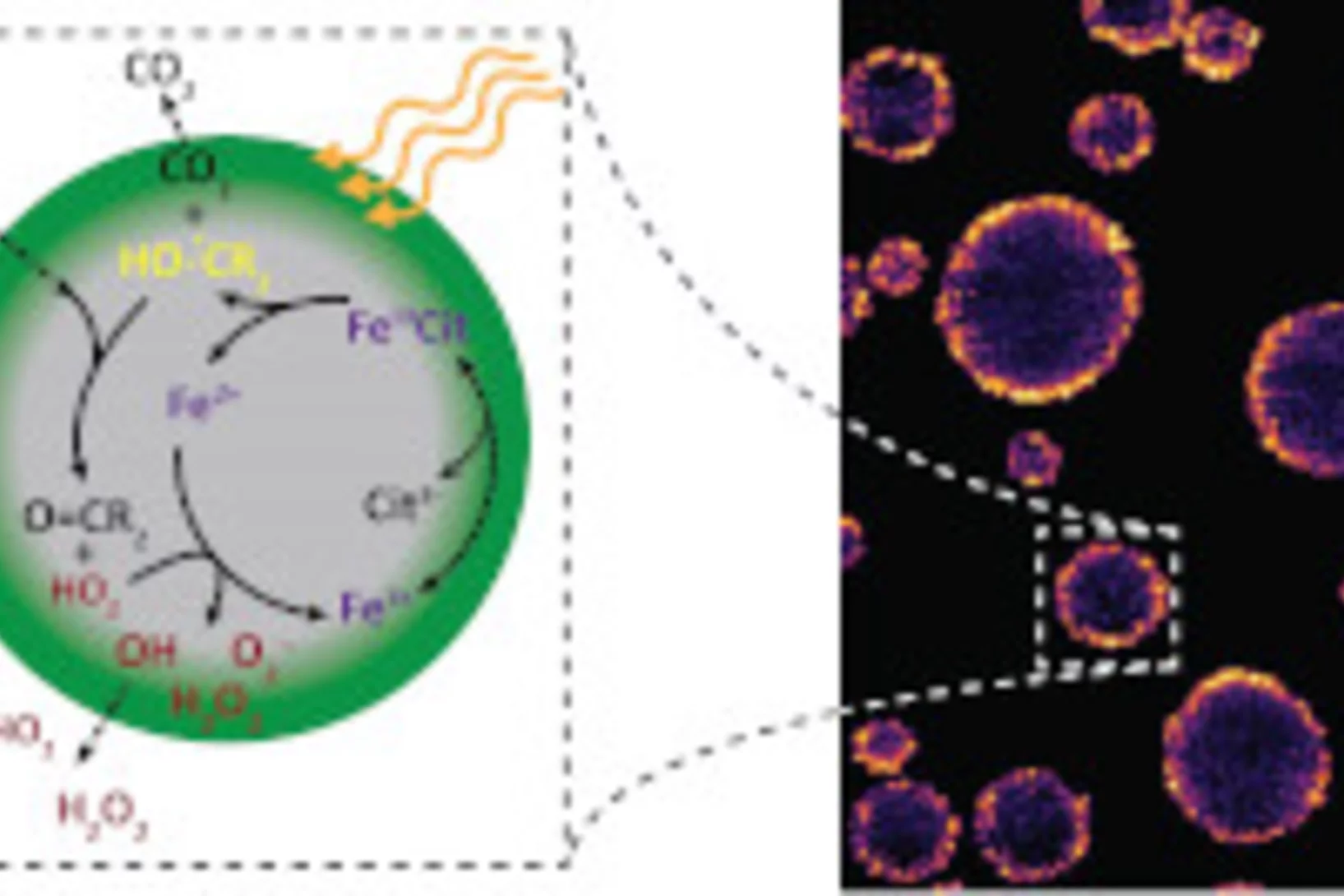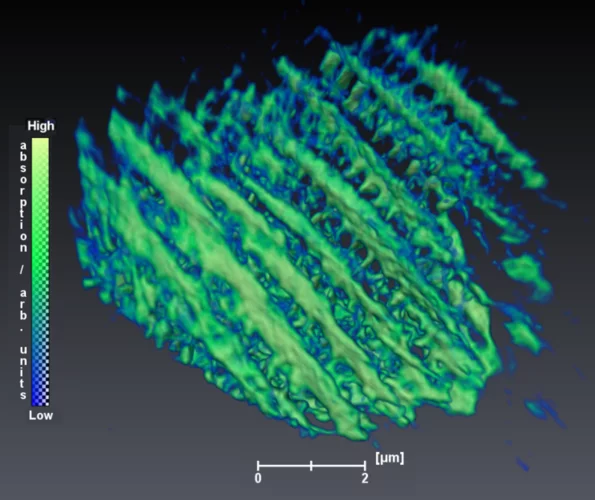Skyrmion topology quantified in 3D
Researchers from an international collaboration between the United States of America and Switzerland have performed three-dimensional magnetic imaging of a magnetic skyrmion using soft X-ray laminography. This allowed for the investigation, in three dimensions, of the topological profile of the magnetic skyrmions.
Three-dimensional magnonics
Researchers from an international collaboration between Switzerland, Italy, and Germany have performed the first time-resolved imaging at sub-ns timescales of the three-dimensional propagation dynamics of a spinwave in a synthetic antiferromagnetic nanostructured device, opening up the possibility to investigate magnon dynamics in complex three-dimensional geometries.
Spatially reconfigurable topological textures in freestanding antiferromagnetic nanomembranes
Researchers from the University of Oxford have imaged, through the use of the soft X-ray microscopy capabilities at the Swiss Light Source, spatially reconfigurable antiferromagnetic states in topologically rich free-standing nanomembranes
Ptychographic Nanoscale Imaging of the Magnetoelectric Coupling in Freestanding Bismuth Ferrite Films
Through soft X-ray ptychographic imaging, researchers at the Swiss Light Source have directly imaged the magneto-electric coupling between the ferroelectric domain structure and the spin-cycloidal state in freestanding BiFeO3 thin films.
First Light at MaxIV for SOPHIE
On January 23rd, 2024, first "Swedish" X-ray light was delivered to the SOPHIE endstation, currently installed at the SoftiMAX beamline of the MaxIV light source.
Biffo the fish: BiFeO3 nanoplate wins the Magnetism Art Competition at JEMS 2023 in Madrid
Dr. Tim A. Butcher from the Microspectroscopy group was awarded the first prize in the "Art in Magnetism" competition of the JEMS 2023 conference with his contribution "Biffo", obtained from a ptychography image of a BiFeO3 nanoplate.
From light-years to nanometers: reconstruction of unknown oscillations in STXM
From light-years to nanometers: by repurposing an algorithm originally developed for the investigation of oscillatory dynamics in astronomical objects, scientists have been able to image non-locked dynamical processes at the nanosecond and nanometer scale.
Nanomaterial aus dem Mittelalter
Das Geheimnis des Zwischgolds wurde am PSI gelüftet.
Nucleation of synthetic antiferromagnetic skyrmions
Magnetic skyrmions stabilized in synthetic antiferromagnets hold promise as nanoscale information carriers in novel non-volatile magnetic memory designs. In this work, scientists in a worldwide collaborative effort have demonstrated the electrically-induced nucleation of magnetic skyrmions in synthetic antiferromagnets, which is a vital stepping stone towards the applicability of these magnetic textures in devices.
Ferrimagnetic Skyrmions: fast and straight
Scientists have demonstrated, through magnetic X-ray microscopy, that magnetic skyrmions stabilized in ferrimagnetic heterostructures can be displaced by electrical currents at high velocities, and exhibit low deflection angles, proving that ferrimagnetic skyrmions are good candidates for fast skyrmionic devices.
Light amplification accelerates chemical reactions in aerosols
Aerosols in the atmosphere react to incident sunlight. This light is amplified in the interior of the aerosol droplets and particles, accelerating reactions. ETH and PSI researchers have now been able to demonstrate and quantify this effect and recommend factoring it into future climate models.
Into the fourth dimension: time-resolved soft X-ray laminography
Combining time-resolved soft X-ray STXM imaging with magnetic laminography, researchers were able to investigate magnetization dynamics in a ferromagnetic microstructure resolved in all three spatial dimensions and in time. Thanks to the possibility of freely selecting the frequency of the excitation applied to the magnetic element, this technique opens the possibility to investigate resonant magneto-dynamical processes, such as e.g. magnetic vortex core gyration and switching, and spinwave emission.
3D printed nanomagnets unveil a world of patterns in the magnetic field
Scientists have used state-of-the-art 3D printing and microscopy to provide a new glimpse of what happens when taking magnets to three-dimensions on the nanoscale – 1000 times smaller than a human hair.
Spin-wave dynamics in a chiral artificial spin system
Artificial spin ices are periodic arrangements of interacting nanomagnets which allow investigating emergent phenomena in the presence of geometric frustration. Recently, it has been shown that artificial spin ices can be used as building blocks for creating functional materials, such as magnonic crystals. Scientists have now investigated the GHz dynamics in a spin ice with a chiral geometry. They found that the system possesses a rich spin-wave spectrum owing to the presence of anisotropic magnetostatic interactions. These results contribute to the understanding of GHz magnetization dynamics in spin ices and are relevant for the realization of reconfigurable magnonic crystals based on spin ices.
Looking inside airborne particles for the chemistry responsible for their adverse health effects.
Chemical changes inside of breathable airborne particles can cause reactive oxygen species (ROS) and carbon centered radicals (CCRs) to form, which are harmful to our bodies and induce oxidative stress in lungs. Using X-ray spectromicroscopy at the PolLux beamline and mimicking the environmental and sunlit conditions aerosol particles experience in the atmosphere near the Earth Surface, it was recently found that highly viscous organic particles with low water content can attain high concentrations of ROS and CCRs that persist over long times. Natural particles like these will occur in ambient humidity below 60% and effectively trap ROS and CCRs inside that react when exposed to light.
Spin-wave emission from vortex cores under static magnetic bias fields
Employing time-resolved STXM imaging, researchers investigated the emission of spin waves from a magnetic vortex core. By applying static magnetic fields, the control of both the shape of the vortex core and of the spatial profile of the emitted spin waves could be demonstrated, allowing for the fabrication of field-tunable spin wave focusing elements.
Magnetic vortices come full circle
The first experimental observation of three-dimensional magnetic ‘vortex rings’ provides fundamental insight into intricate nanoscale structures inside bulk magnets, and offers fresh perspectives for magnetic devices.
Tailoring Spin-Wave Channels in an Artificial Spin Ice
Magnonic crystals are periodic magnetic structures, which are attracting great interest because of their potential use in low-power information technology based on spin waves, or magnons. Artificial spin ices have been recently studied as reconfigurable magnonic crystals, but achieving the required combination of magnetic state reconfigurability and desired magnon dispersions remains challenging. Here, researchers propose a hybrid system that makes use of a magnetic thin film underlayer to couple and strengthen the interaction between the artificial spin ice’s nanoelements though spin waves. Moreover, the magnetic state of the artificial spin ice gives rise to directional spin wave channels in the underlayer. This hybrid system opens a new direction for band structure engineering in reconfigurable magnonic crystals.
Logic operations with domain walls
A collaboration of scientists from the ETH Zürich and the Paul Scherrer Institute successfully demonstrated the all-electric operation of a magnetic domain-wall based NAND logic gate, paving the way towards the development of logic applications beyond the conventional metal-oxide semiconductor technology. The work has been published in the journal Nature.
Optics for spins
In this work, published on the front cover page of Advanced Materials, an international collaboration of Italian, American, and Swiss scientists demonstrated a novel concept for the generation and manipulation of spin waves, paving the way towards the development of magnonic nano-processors.
Can skyrmions read?
Can a skyrmion-based device be used to read a handwritten text? In this work, an international scientist collaboration led by the Korea Institute of Technology and the IBM Watson research center could provide a first answer to this question by fabricating a proof-of-principle single-neuron artificial neural network, using X-ray magnetic microscopy at the Swiss Light Source to investigate its performances.
Many skyrmions, one angle
Employing a tailored multilayered magnetic film, optimized for the zero-field stabilization of magnetic skyrmions, researchers have investigated the influence of the skyrmion diameter on its current-induced sideways motion, uncovering mechanisms that allow for this topological property to be controlled.
Soft X-ray Laminography: 3D imaging with powerful contrast mechanisms
3D imaging using synchrotron radiation is a widely used tool that allows access to the inner structure of complex objects. An international and interdisciplinary consortium of scientists from the Swiss Light Source (PolLux and cSAXs), the Friedrich-Alexander-Universität Erlangen-Nürnberg, and the University of Cambridge developed the new 3D imaging technique of Soft X-ray Laminography (SoXL). SoXL allows for the investigation of thin and extended samples while taking advantage of the characteristic absorption contrast mechanisms in the soft X-ray range, providing 3D information with nm spatial resolution.
Wrinkles and wrinklons: magnetic films with tuneable topographies
Sebastian Gliga has been awarded an SNF Spark grant to investigate the possibility of combining magnetic thin films with graphene to create logical devices. As electronic components, such as those found in computer CPUs, are miniaturized, they generate waste heatand alternative schemes are being explored to create novel data processing architectures. This project, to be carried out in the Microspectroscopy group (PSD), aims to exploit the tunable topography of graphene to create magnetic systems, which allow simultaneously guiding spin waves and performing logical operations based on spin wave interference.
Nano-engineered contact for the zero-field nucleation of magnetic skyrmions
Researchers in a joint collaboration between the PolLux endstation of the Swiss Light Source and the University of Leeds have achieved the reliable and reproducible electrical nucleation of magnetic skyrmions from a nano-engineered point contact structure, investigating the physical mechanisms driving the nucleation process.
Let’s not make big waves
A team of researchers generates ultra-short spin waves in an astoundingly simple material. Due to its potential to make computers faster and smartphones more efficient, spintronics is considered a promising concept for the future of electronics. In a collaboration including the Paul Scherrer Institut, a team of researchers has now successfully generated so-called spin waves much more easily and efficiently than was previously deemed possible. The researchers are presenting their results in the journal Physical Review Letters (DOI: 10.1103/PhysRevLett.122.117202).
Chemically mapping ice forming particles
Scientists have just nucleated ice in an X-ray microscope for the first time and they created chemical maps of those responsible.
A new spin in nano-electronics
In recent years, electronic data processing has been evolving in one direction only: The industry has downsized its components to the nanometer range. But this process is now reaching its physical limits. Researchers at the Helmholtz-Zentrum Dresden-Rossendorf (HZDR) and the Paul Scherrer Institut (PSI) are therefore exploring spin waves or so-called magnons – a promising alternative for transporting information in more compact microchips. Cooperating with international partners, they have successfully generated and controlled extremely short-wavelength spin waves. The physicists achieved this feat by harnessing a natural magnetic phenomenon, as they explain in the journal Nature Nanotechnology.
Sub-ns magnetic domain wall motion dynamics
Magnetic domain walls can be reliably displaced by electrical currents, allowing for the fabrication of retentive magnetic memory elements without mechanically moving parts, such as e.g. the magnetic racetrack memory. Researchers in a joint collaboration between the PolLux endstation of the Swiss Light Source and the University of Leeds were able to investigate the dynamics of magnetic domain wall motion with a sub-ns time step, providing a substantial step forward towards the unraveling of the physical processes behind the current- and magnetic field-induced motion of magnetic domains.
Discrete Hall contribution of magnetic skyrmions
The reliable electrical detection of magnetic skyrmions is of fundamental importance for the application of such topological magnetic quasi-particles for data storage devices. Researchers in a joint collaboration between the University of Leeds and the PolLux endstation have investigated the electrical detection of isolated magnetic skyrmions in applications-relevant nanostructured devices, observing the presence of a strong skyrmion-dependent contribution to the Hall resistivity.





























